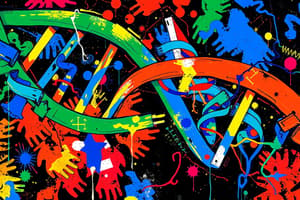Podcast
Questions and Answers
What is the primary function of messenger RNA (mRNA)?
What is the primary function of messenger RNA (mRNA)?
- To transport amino acids during protein synthesis
- To regulate gene expression through RNA interference
- To serve as a structural component of ribosomes
- To carry information from DNA to ribosomes for protein synthesis (correct)
Which type of RNA makes up the largest portion of total RNA in a cell?
Which type of RNA makes up the largest portion of total RNA in a cell?
- Messenger RNA (mRNA)
- Transfer RNA (tRNA)
- Ribosomal RNA (rRNA) (correct)
- Non-coding RNA (ncRNA)
What characterizes transfer RNA (tRNA) among the different types of RNA?
What characterizes transfer RNA (tRNA) among the different types of RNA?
- It has the longest nucleotide sequence.
- It is primarily involved in the transcription process.
- It is essential for linking amino acids during protein synthesis. (correct)
- It constitutes the majority of RNA in the cell.
How do ribosomal RNA (rRNA) molecules function within ribosomes?
How do ribosomal RNA (rRNA) molecules function within ribosomes?
Which statement about non-coding RNAs (ncRNA) is true?
Which statement about non-coding RNAs (ncRNA) is true?
What is a major structural difference between RNA and DNA?
What is a major structural difference between RNA and DNA?
Which of the following best describes a function of non-coding RNAs?
Which of the following best describes a function of non-coding RNAs?
What type of chromatin is primarily associated with gene silencing?
What type of chromatin is primarily associated with gene silencing?
How are nucleosomes organized within chromatin?
How are nucleosomes organized within chromatin?
Which statement accurately reflects gene expression regulation?
Which statement accurately reflects gene expression regulation?
What is the estimated percentage of the human genome that consists of coding DNA?
What is the estimated percentage of the human genome that consists of coding DNA?
What defines genetic polymorphism in the context of DNA?
What defines genetic polymorphism in the context of DNA?
What role do centromeres play in cellular division?
What role do centromeres play in cellular division?
What is the primary function of the linker histone H1 in relation to nucleosomes?
What is the primary function of the linker histone H1 in relation to nucleosomes?
Which characteristic distinguishes euchromatin from heterochromatin?
Which characteristic distinguishes euchromatin from heterochromatin?
What can be concluded about the role of different H1 histone subtypes in gene expression?
What can be concluded about the role of different H1 histone subtypes in gene expression?
Which statement accurately describes the composition of heterochromatin?
Which statement accurately describes the composition of heterochromatin?
What is the role of the arrangement of linker histones on chromatin fiber?
What is the role of the arrangement of linker histones on chromatin fiber?
Which of the following describes a significant feature of chromosomes?
Which of the following describes a significant feature of chromosomes?
Which of the following statements reflects a similarity between euchromatin and heterochromatin?
Which of the following statements reflects a similarity between euchromatin and heterochromatin?
In the context of gene regulation, what is the importance of histone H1 subtypes?
In the context of gene regulation, what is the importance of histone H1 subtypes?
Flashcards
Linker histone H1
Linker histone H1
A histone protein that binds to DNA entry/exit sites of nucleosomes, stabilizing them and higher-order chromatin structures.
Nucleosome
Nucleosome
A structural unit of DNA wrapped around histone proteins.
Chromatin
Chromatin
DNA and protein complex that condenses to form chromosomes.
Euchromatin
Euchromatin
Signup and view all the flashcards
Heterochromatin
Heterochromatin
Signup and view all the flashcards
Chromosome
Chromosome
Signup and view all the flashcards
H1 subtypes
H1 subtypes
Signup and view all the flashcards
Position effect
Position effect
Signup and view all the flashcards
What is mRNA?
What is mRNA?
Signup and view all the flashcards
What is tRNA?
What is tRNA?
Signup and view all the flashcards
What is rRNA?
What is rRNA?
Signup and view all the flashcards
Types of RNA
Types of RNA
Signup and view all the flashcards
Non-coding RNA
Non-coding RNA
Signup and view all the flashcards
Centromere Function
Centromere Function
Signup and view all the flashcards
Centromere Location
Centromere Location
Signup and view all the flashcards
Human Genome: What is it?
Human Genome: What is it?
Signup and view all the flashcards
Nuclear Genome Size
Nuclear Genome Size
Signup and view all the flashcards
Gene Count in Humans
Gene Count in Humans
Signup and view all the flashcards
Junk DNA
Junk DNA
Signup and view all the flashcards
Human Genome Project
Human Genome Project
Signup and view all the flashcards
Genetic Polymorphism
Genetic Polymorphism
Signup and view all the flashcards
Study Notes
Introduction to Molecular Biology (2)
- Course module: Cell biology and molecular biology
- Academic year: 2022-2023
- Instructor: Pr. Raouf Alami
- Course material covers: RNA and DNA, eukaryotic chromosomes organization, human genome, genetic polymorphisms, and relevant methods/tests
Course Contents
-
Ribonucleic acid (RNA):
- RNA and DNA structure comparison
- RNA size variation
- RNA backbone components (phosphate and ribose)
- RNA structures (primary, secondary, and tertiary)
- RNA functions (coding, decoding, regulating, expressing genes, carrying out biochemical reactions, and serving as enzymes)
- RNA integrity assessment methods (denaturing agarose gel with ethidium bromide)
- Types of RNA (mRNA, rRNA, tRNA, non-coding RNAs, microRNA and ncRNA)
- Relative abundance of each RNA type in a human cell (rRNA ~ 80%, tRNA~15%, mRNA ~ 5%)
-
Organization of eukaryotic chromosomes:
- Chromatin structure (nucleosome, 30nm chromatin fiber, and higher-level structures)
- Nucleosome makeup (histone octamer and DNA wrapping)
- Telomeres (repeated DNA sequences at chromosome ends)
- Telomere sequence (TTAGGG)
- Telomere function (protecting chromosome ends)
- Eukaryotic nucleus size ranges from 5-10 µm
- Euchromatin vs heterochromatin (structural and functional differences)
- Euchromatin (less compact, rich in genes, actively transcribed)
- Heterochromatin (more compact, less active transcription)
-
Human Genome:
- Genome definition (complete set of nucleic acid sequences)
- Chromosome number (23 pairs in humans)
- DNA molecule regions (coding and non-coding)
- Human Genome Project (HGP) overview (goal was to determine the sequence of 3 billion base pairs, including identifying genes)
- Estimated gene number (20,000 – 25,000)
- Gene redundancy (two copies of each gene, one from each parent)
- Non-coding DNA function (genetic regulation and other roles)
-
Genetic Polymorphism:
- Definition (variation in DNA sequences among individuals/populations)
- Types (single nucleotide polymorphisms (SNPs), short tandem repeats (STRs))
- Application in forensic investigations (comparing DNA profiles to identify suspects)
- Paternity testing approach (comparing DNA profiles for biological father determination)
-
Quiz Questions:
- Number of chromatins per chromosome (1)
- Number of DNA molecules per chromosome (1)
- Three major differences between RNA and DNA
- RNA backbone components (phosphate and ribose)
- Method for assessing RNA integrity (run an aliquot of RNA on a denaturing agarose gel)
- mRNA first description (1961 by Jacob and Monod)
- tRNA function (essential component of translation)
- Non-coding RNA examples (tRNA, rRNA, hammerhead ribozyme)
- Chromatin first description (1880 by Fleming)
- Base pairs per nucleosome (~ 147)
- Proteins per nucleosome (8)
- DNA compaction ratio for a chromosome (10,000-20,000 fold)
- H1 histone function (linker histones for DNA entry/exit and stabilize the 30nm chromatin fiber)
- Similarities between euchromatin and heterochromatin (both made up of nucleotides, visible more distinctly in interphase & interact with histones)
- Differences between euchromatin and heterochromatin
- Heterochromatin presence in prokaryotes (yes)
- Role of chromosomes (protecting DNA from tangling & damage)
- Definition of karyotype (lab produced image of chromosomes)
- Human telomere sequence (TTAGGG)
- Telomere repeated times (~ 3,000 to 15,000)
- Role of centromeres (linking pair of sister chromatids during cell division)
-
Number of DNA molecules in a human cell. (46)
-
Definition of "junk DNA" (regions of DNA that don't code for proteins in genetics)
-
Date of the human genome gold standard release (2003)
-
SNP meaning (single nucleotide polymorphism)
-
Tandem repeat application (genetic markers and DNA fingerprinting)
Studying That Suits You
Use AI to generate personalized quizzes and flashcards to suit your learning preferences.





